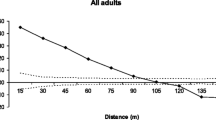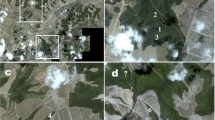Abstract
In landscapes which are predominately characterised by agriculture, natural ecosystems are often reduced to a mosaic of scattered patches of natural vegetation. Species with formerly connected distribution ranges now have restricted gene flow among populations. This has isolating effects upon population structure, because species are often confined by their limited dispersal capabilities. In this study, we test the effects of habitat fragmentation, precipitation, and isolation of populations on the genetic structure (AFLP) and fitness of the Asteraceae Catananche lutea. Our study area is an agro-dominated ecosystem in the desert–Mediterranean transition zone of the Southern Judea Lowlands in Israel. Our analysis revealed an intermediate level of intra-population genetic diversity across the study site with reduced genetic diversity on smaller scale. Although the size of the whole study area was relatively small (20 × 45 km), we found isolation by distance to be effective. We detected a high level of genetic differentiation among populations but genetic structure did not reflect spatial patterns. Population genetic diversity was correlated neither with position along the precipitation gradient nor with different seed types or other plant fitness variables in C. lutea.




Similar content being viewed by others
References
Ackermann O, Svoray T, Haiman M (2008) Nari (calcrete) outcrop contribution to ancient agricultural terraces in the Southern Shephelah, Israel: insights from digital terrain analysis and a geoarchaeological field survey. J Archaeol Sci 35:930–941
Aguilar R, Quesada M, Ashworth L, Herreriasdiego Y, Lobo J (2008) Genetic consequences of habitat fragmentation in plant populations: susceptible signals in plant traits and methodological approaches. Mol Ecol 17:5177–5188
Alexander HM, Foster BL, Ballantyne F, Collins CD, Antonovics J, Holt RD (2012) Metapopulations and metacommunities: combining spatial and temporal perspectives in plant ecology. J Ecol 100:88–103
Bates D, Maechler M, Bolker B (2011) lme4: Linear mixed-effects models using S4 classes. R package version 0.999375-42. http://CRAN.R-project.org/package=lme4
Ben-Gai T, Bitan A, Manes A, Alpert P (1994) Long-term changes in annual rainfall patterns in southern Israel. Theor Appl Climatol 49:59–67
Campbell JM, Abbott RJ (1976) Variability of outcrossing frequency in Senecio vulgaris L. Heredity 36:267–274
Cheplick GP (1987) The ecology of amphicarpic plants. TREE 2:97–101
Cheplick GP (1996) Do seed germination patterns in cleistogamous annual grasses reduce the risk of sibling competition? J Ecol 84:247–255
Dan J, Yaalon DH, Koyumdjisky H, Raz Z (1976) The soils of Israel. Volcani Centre Pamphlet 159:43
Dannemann A (2000) Der Einfluss von Fragmentierung und Populationsgröße auf die genetische Variation und Fitness von seltenen Pflanzenarten am Beispiel von Biscutella laevigata (Brassicaceae). Diss Bot. J. Cramer, Berlin, Stuttgart
Duminil J, Hardy OJ, Petit RJ (2009) Plant traits correlated with generation time directly affect inbreeding depression and mating system and indirectly genetic structure. BMC Evol Biol 9:177
Ehrich D (2006) AFLPdat: a collection of R functions for convenient handling of AFLP data. Mol Ecol Notes 6:603–604
Ellner S, Shmida A (1981) Why are adaptations for long-range seed dispersal rare in desert plants? Oecologia 5:133–144
Ellstrand NC, Elam DR (1993) Population genetic consequences of small population size: implications for plant conservation. Annu Rev Ecol Syst 24:217–242
Evanno G, Regnaut S, Goudet J (2005) Detecting the number of clusters of individuals using the software Structure: a simulation study. Mol Ecol 14:2611–2620
Excoffier L, Laval G, Schneider S (2005) Arlequin ver. 3.0: an integrated software package for population genetics data analysis. Evol Bioinform Online 1:47–50
Fahrig L (2003) Effects of habitat fragmentation on biodiversity. Annu Rev Ecol Evol Syst 34:487–515
Feinbrun-Donath N (1978) Flora palaestina part 3. Isr Acad Sci Humanities, Jerusalem
Fischer M, Matthies D (1998) Effects of population size in the rare plant Gentianella germanica. J Ecol 86:195–204
Fischer M, Stöcklin J (1997) Local extinctions of plants in remnants of extensively used calcareous grasslands 1950–85. Conserv Biol 11:727–737
Gaudeul M, Taberlet P, Till-Bottraud I (2000) Genetic diversity in an endangered alpine plant, Eryngium alpinum L. (Apiaceae), inferred from amplified fragment length polymorphism markers. Mol Ecol 9:1625–1637
Giladi I, Ziv Y, May F, Jeltsch F (2011) Scale-dependent determinants of plant species richness in a semi-arid fragmented agro-ecosystem. J Veg Sci 22:983–996
Givnish TJ (2010) Ecology of plant speciation. Taxon 59(5):1326–1366
Goldblatt P (1984) Index to Plant Chromosome Numbers, 1979–1981. Monogr Syst Bot Missouri Bot Gard 8:1–427
Goldreich Y (2003) The climate of Israel—observations, research, and applications. Kluwer Academic, Dordrecht
Haldimann P, Steinger T, Müller-Schärer H (2003) Low genetic differentiation among seasonal cohorts in Senecio vulgaris as revealed by amplified fragment length polymorphism analysis. Mol Ecol 12(10):2541–2551
Hamrick JL, Godt MJW (1996) Effects of life history traits on genetic diversity in plant species. Philos Trans R Soc Lond Ser B Biol Sci 351:1291–1298
Hamrick JL, Linhart YB, Mitton JB (1979) Relationships between life history characteristics and electrophoretically detectable genetic variation in plants. Annu Rev Ecol Syst 10:173–200
Hancock PJF, Britton NF (2006) Adaptive responses to spatial aggregation and habitat destruction in heterogeneous landscapes. Evol Ecol Res 8(8):1349–1376
Hanski I, Gaggiotti OE (2004) Metapopulation biology: past, present, and future. In: Hanski I, Gaggiotti OE (eds) Ecology, genetics, and evolution of metapopulations. Elsevier Academic, Amsterdam, pp 3–21
Harel D, Holzapfel C, Sternberg M (2011) Seed mass and dormancy of annual plants populations and communities decreases with aridity and rainfall predictability. Basic Appl Ecol 12:674–684
Jakobsson M, Rosenberg NA (2007) CLUMPP: a cluster matching and permutation program for dealing with label switching and multimodality in analysis of population structure. Bioinformatics 23:1801–1806
Keiper FJ, McConchie R (2000) An analysis of genetic variation in natural populations of Sticherus flabellatus [(R. Br.) St John] using amplified fragment length polymorphism (AFLP) markers. Mol Ecol 9(5):571–582
Kim SC, Lee C, Santos-Guerra A (2005) Genetic analysis and conservation of the endangered Canary Island woody sow-thistle, Sonchus gandogeri (Asteraceae). J Plant Res 118(2):147–153
Kwak MM, Velterop O, van Andel J (1998) Pollen and gene flow in fragmented habitats. Appl Veg Sci 1:37–54
Lankau RA (2011) Conflicts in maintaining biodiversity at multiple scales. Mol Ecol 20(19):2035–2037
Lauterbach D, Ristow M, Gemeinholzer B (2011) Genetic population structure, fitness variation and the importance of population history in remnant populations of the endangered plant Silene chlorantha EHRH. (Caryophyllaceae). Plant Biol 13(4):667–677
Lauterbach D, Ristow M, Gemeinholzer B (2012) Population genetics and fitness in fragmented populations of the dioecious and endangered Spanish Catchfly (Silene otites). Plant Syst Evol 298(1):155–164
Leiss K, Müller-Schärer H (2001) Adaptation of Senecio vulgaris to ruderal and agricultural habitats. Am J Bot 88:1593–1599
Lynch M, Milligan BG (1994) Analysis of population genetic structure with RAPD markers. Mol Ecol 3:91–99
Mazor S (2006) Landscape change in the Southern Judean lowlands and the effect of patch attributes on species richness in semi-arid environment: embedding fuzzy logic in GIS. In: Department of Geography and Environmental Development. Ben-Gurion University, Beer Sheva
Michl T, Huck S, Schmitt T, Liebrich A, Haase P, Büdel B (2010) The molecular population structure of the tall forb Cicerbita alpina (Asteraceae) supports the idea of cryptic glacial refugia in central Europe. Bot J Linn Soc 164:142–154
Moilanen A, Nieminen M (2002) Simple connectivity measures in spatial ecology. Ecol 83:1131–1145
Morandin LA, Winstona ML (2006) Pollinators provide economic incentive to preserve natural land in agroecosystems. Agric Ecosyst Environ 116(3–4):289–292
Muellner AN, Tremetsberger K, Stuessy T, Baeza CM (2005) Pleistocene refugia and recolonization routes in the southern Andes: insights from Hypochaeris palustris (Asteraceae, Lactuceae). Mol Ecol 14:203–212
Naveh Z, Dan J (1973) The human degradation of Mediterranean landscapes in Israel. In: di Castri F, Mooney HA (eds) Mediterranean type ecosystems, origin and structure. Springer, New York, pp 370–390
Nybom H, Bartish IV (2000) Effects of life history traits and sampling strategies on genetic diversity estimates obtained with RAPD markers in plants. Perspect Plant Ecol Evol Syst 3:93–114
Poschlod P, WallisDeVries MF (2002) The historical and socioeconomic perspective of calcareous grasslands—lessons from the distant and recent past. Biol Conserv 104:361–376
Poschlod P, Bakker JP, Kahmen S (2005) Changing land use and its impact on biodiversity. Basic Appl Ecol 6:93–98
Prinz K, Weising K, Hensen I (2009) Genetic structure of coastal and inland populations of the annual halophyte Suaeda maritima (L.) dumort. in Central Europe, inferred from amplified fragment length polymorphism markers. Plant Biol 11(6):812–820
Pritchard JK, Stephens M, Donnelly P (2000) Inference of population structure using multilocus genotype data. Genetics 155:945–959
R Development Core Team (2011) R: a language and environment for statistical computing. R Foundation for Statistical Computing, Vienna, Austria, http://www.R-project.org
Rosenberg NA (2004) DISTRUCT: a program for the graphical display of population structure. Mol Ecol Notes 4:137–138
Ruiz de Clavijo E (1995) The ecological significance of fruit heteromorphism in the Amphicarpic species Catananche lutea (Asteraceae). Int J Plant Sci 156(6):824–833
Ruiz de Clavijo E, Jimenez MJ (1998) The influence of achene type and plant density on growth and biomass allocation in the heterocarpic annual Catananche lutea (Asteraceae). Int J Plant Sci 159(4):637–647
Stadler K, Koch M, Bernhardt KG, Greimler J (2010) Spatial arrangement and genetic structure in Gentianella aspera in a regional, local and temporal context. Plant Syst Evol 286:7–19
Svoray T, Mazor S, Pua B (2007) How is shrub cover related to soil moisture and patch geometry in the fragmented landscape of the Northern Negev desert? Landsc Ecol 22:105–116
Swofford DL (2003) PAUP* phylogenetic analysis using parsimony (*and other methods). Version 4. Sinauer Associates, Sunderland
Tero N, Aspi J, Siikamäki P, Jäkäläniemi A, Tuomi J (2003) Genetic structure and gene flow in a metapopulation of an endangered plant species, Silene tatarica. Mol Ecol 12:2073–2085
Tremetsberger K, Stuessy TF, Guo Y-P, Baeza CM, Weiss H, Samuel RM (2003) Amplified fragment length polymorphism (AFLP) variation within and among populations of Hypochaeris acaulis (Asteraceae) of Andean southern South America. Taxon 52:237–245
Turner ME, Stephens JC, Anderson WW (1982) Homozygosity and patch structure in plant populations as a result of nearest-neighbor pollination. Proc Nat Acad Sci USA 79:203–207
Vandepitte K, Roldán-Ruiz I, Leus L, Jacquemyn H, Honnay O (2009) Canopy closure shapes clonal diversity and fine-scale genetic structure in the dioecious understorey perennial Mercurialis perennis. J Ecol 97:404–414
Vekemans X (2002) AFLP-SURV version 1.0. Laboratoire de Génétique et Ecologie Végétale, Université Libre de Bruxelles, Belgium
Vellend M, Geber MA (2005) Connections between species diversity and genetic diversity. Ecol Lett 8:767–781
Venable DL, Brown JS (1988) The selective interactions of dispersal, dormancy and seed size as adaptations for reducing risks in variable environments. Am Nat 131:360–384
Vos P, Hogers R, Bleeker M, Reijans M, van de Lee T, Hornes M, Frijters A, Pot J, Peleman J, Kuiper M, Zabeau M (1995) AFLP: a new technique for DNA fingerprinting. Nucleic Acids Res 23:4407–4414
Wright S (1943) Isolation by distance. Genetics 28:114–138
Wright S (1978) Evolution and the genetics of populations, vol 4. University of Chicago Press, Chicago
Yaacobi G, Ziv Y, Rosenzweig ML (2007) Habitat fragmentation may not matter to species diversity. Proc R Soc B 274:2409–2412
Zhivotovsky LA (1999) Estimating population structure in diploids with multilocus dominant DNA markers. Mol Ecol 8:907–913
Acknowledgments
We thank the Friends of the Botanic Garden Berlin-Dahlem, for financial support, and Itamar Giladi and Yaron Ziv, Beersheva, for their hospitality and support and for the various discussions on plants and landscape of the study site.
Author information
Authors and Affiliations
Corresponding author
Rights and permissions
About this article
Cite this article
Gemeinholzer, B., May, F., Ristow, M. et al. Strong genetic differentiation on a fragmentation gradient among populations of the heterocarpic annual Catananche lutea L. (Asteraceae). Plant Syst Evol 298, 1585–1596 (2012). https://doi.org/10.1007/s00606-012-0661-1
Received:
Accepted:
Published:
Issue Date:
DOI: https://doi.org/10.1007/s00606-012-0661-1




